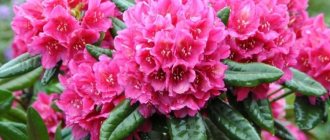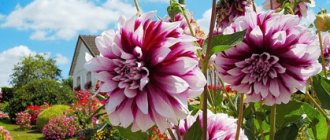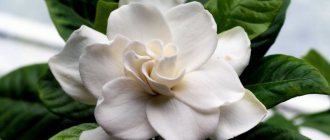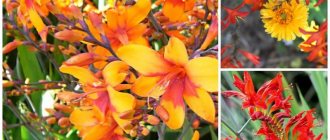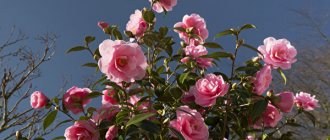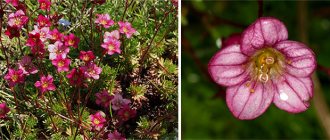general description
Rhododendron is an evergreen shrub of the heather family. There is a wide variety, numbering up to 3000 species. Among them there are both creeping shrubs and trees reaching thirty meters in height.
There are deciduous varieties. Translated from Latin, rhododendron means tree of roses.
Rhododendron is represented by a wide variety of species
Indeed, the flowers, formed in lush clusters, resemble pink flowers, which vary in size and shape depending on the variety. The smallest ones are a few millimeters in diameter, and the largest ones reach 20 cm.
Cultivated for its beautiful flowers of varied colors:
- purple
- red
- yellow
- orange
- pink
- raspberry
- white
- The shape of flowers is varied, there are: funnel-shaped, tubular, bell-shaped, wheel-shaped. The flowers produce a fruit, which is a five-leaf capsule filled with seeds up to 2 mm.
- Decorative egg-shaped leaves form an elegant crown. There are specimens with deep-set leaves and petioles. The roots have a surface system of many thin layers, which greatly facilitates replanting the plant.
They grow wild in coastal areas of seas, rivers, and on the northern slopes of the mountains of Southeast Asia.
White Lights
White Lights is one of the varieties of deciduous azalea. This rhododendron can withstand frosts from -34°C to -42°C! So you can safely plant it in the middle zone and forget about winter shelter.
In May, the pink buds turn into large pinkish-pearl flowers with small golden splashes. Over time, the petals turn white. In autumn the foliage takes on a dark bronze hue.
| Flowering time | Bush height (cm) | Bush width (cm) | Distance between bushes (cm) | Peculiarities |
| May June | 120-150 | 120-150 | 120-150 | Strong aroma |
Do you have other winter-hardy rhododendrons in your garden?
Landing
When is the best time to plant rhododendron?
Garden rhododendron can be planted in the ground in the spring (from April to May) and autumn (from September to November). The optimal time for planting is indicated, although it can be done at another period, the main thing is that the plant is not flowering. In northern latitudes, it is recommended to plant cold-resistant varieties.
For planting, choose a shaded place with loose, well-fertilized acidic soil. In case of high groundwater, a raised bed is made to avoid rotting. In order for the bush to grow well, you need to carefully select the surrounding trees. It should not be planted in close proximity to crops whose roots are located at the same depth as rhododendrons.
Spring and autumn are the best times to plant a plant.
Garden rhododendron can be planted in the ground in the spring (from April to May) and autumn (from September to November). The optimal time for planting is indicated, although it can be done at another period, the main thing is that the plant is not flowering. In northern latitudes, it is recommended to plant cold-resistant varieties.
For planting, choose a shaded place with loose, well-fertilized acidic soil. In case of high groundwater, a raised bed is made to avoid rotting. In order for the bush to grow well, you need to carefully select the surrounding trees. It should not be planted in close proximity to crops whose roots are located at the same depth as rhododendrons.
Good neighbors can be:
- pear
- Apple tree
- pine
- larch
- oak
These trees have roots that are quite deep. And poplar, elm, alder, maple, chestnut, linden will take away water and nutrition from the bush. If it is not possible to avoid such a neighborhood, materials such as roofing felt, geotextile, or polyethylene film will come to the rescue, which separate the border of the plant’s growth.
How to plant correctly
The main condition for planting is the acidity of the soil, in addition to the fact that it must be well fertilized with humus. You can check for acidity using a simple folk method. To do this, currant or cherry leaves are poured with boiling water.
Throw a handful of soil into the cooled water. If the water changes color to blue, then the soil should be acidified. This is done by introducing rotted needles or sawdust of coniferous wood into the soil.
Before planting, the soil should be fertilized
If the water changes color to green, this indicates the neutrality of the soil, and if it turns red, it means everything is in order, the soil has the desired acidic composition. A hole is dug half a meter deep and 60 cm wide. A mixture of peat and loam, taken in a ratio of 8: 3.5, is poured in and compacted. Make a hole larger than the root system of the plant.
The seedlings are prepared for planting; they are kept in water until the rise of air bubbles stops. The seedling is lowered into the hole so that the root collar is level with the ground.
The soil around is compacted. The bush should be watered abundantly, and the soil around should be mulched 5 cm with moss, peat or oak leaves. If there are a lot of flower buds on the bush, some of them are removed so that the main forces of the bush are spent on rooting.
If plants are planted individually, they are tied to support pegs, which are removed after final rooting.
Care
Beautiful rhododendron is the result of proper care
The soil around the rhododendron cannot be loosened by hand to avoid damaging the roots located close to the surface.
Further care involves typical procedures for other crops:
- watering
- weeding
- spraying
- feeding
- bush pruning
- control of harmful insects and diseases
Watering
Rhododendron is a moisture-loving plant, but excessive watering causes root rot. Water with soft water: settled or rain.
Excessive watering harms the plant
You can soften the water for irrigation by adding a few handfuls of peat a day before watering. The plant is sensitive to both drought and excess moisture. You need to be careful here. Watering is carried out when the leaves lose their elasticity and shine.
Weeding
Weeds need to be pulled out by hand
It is recommended to pull out weeds by hand, since using a hoe can damage the roots of high-lying plants.
Spraying
Frequent spraying of the bush is necessary
Since rhododendron comes from countries with a humid climate, frequent spraying of the bush with soft water is recommended.
Top dressing
The plant needs constant feeding, even if the bush was planted this year. Fertilizing begins in early spring and ends at the end of July, when flowering ends and young shoots begin to emerge.
The fertilizer is made from half-rotted cow dung. Manure diluted with water in a ratio of 1:15 is kept for several days. Before applying fertilizer, the bush is watered.
Long lasting fertilizer
Mineral fertilizers include: phosphate, nitrate, potassium sulfate, ammonium sulfate, calcium and magnesium sulfate, superphosphate. Calcium, magnesium and potassium fertilizers are taken in a very small proportion: 1.2: 1000.
Nitrogen-containing fertilizers are applied in early spring - 50 grams of magnesium sulfate and the same amount of ammonium sulfate per 1 m2. In early June, after flowering, use 20 grams. potassium sulfate and superphosphate, 40 grams of ammonium sulfate per 1 m 2. Later, in July, 20 grams are added. potassium sulfate and superphosphate.
Bush pruning
Rhododendron almost does not need to form a crown, as it has the correct outline. Pruning should be carried out periodically to remove dried branches and rejuvenate the bush. Sometimes it becomes necessary to regulate certain sizes of a bush.
Rhododendron pruning is carried out in the spring.
Pruning is carried out in early spring. Cutting areas of branches up to 4 mm thick must be treated with garden varnish. Pruning should be minor, leaving at least three quarters of the bush.
Rhododendrons bloom magnificently within a year. To have a beautifully flowering bush, it is recommended to annually remove faded inflorescences immediately after flowering. This will provide the plant with an influx of strength to form new buds next year.
Control of harmful insects and diseases
Mealybug
Due to poor air access to the roots, rhododendrons are susceptible to infection with fungal diseases.
The most common are:
- rust
- chlorosis
- leaf spot
- cancer
Yellowing of the leaves indicates chlorosis. To get rid of it, iron chelate is added to irrigation water. You can use a solution of citric acid with iron sulfate. Copper sulfate preparations are used to combat spotting and rust.
Spraying the bush with Bordeaux mixture in early spring and late autumn helps. It also prevents the occurrence of cancer. If symptoms have already appeared, diseased shoots are cut off.
The plant is often attacked by pests:
- weevils
- scale insects
- mealybugs
- spider mites
- bedbugs
- rhododendron flies
- slugs, snails
Shellfish are collected by hand. For preventive purposes, the plant is treated with an 8% solution of TMTD fungicide. Weevils, bedbugs and ticks are destroyed with diazinon. Karbofos is used against flies, mealybugs, and scale insects.
Secrets of success
In the garden, it is better to plant Rhododendron next to conifers. Plants look harmonious in a landscape composition and create a favorable environment for another species.
IN THE PHOTO: Coniferous trees are an excellent “company” for Rhododendrons.
The moisture-loving Rhododendron feels great on the shore of a garden pond.
Acidified water is optimal for watering the plant. For acidification in 10 l. add 3-4 g of oxalic acid to water.
It is not recommended to feed Rhododendron at the end of summer. This leads to untimely growth of young shoots and further freezing of the plant in winter. In severe frosts, bushes and trees are covered with spruce branches or lutrasil.
To preserve moisture and reduce the number of weeds, the soil around Rhododendrons is mulched with peat or pine needles.
Reproduction
Rhododendron is propagated:
1 cuttings
2layers
3 seeds
Cuttings
Plant cuttings
Semi-lignified shoots are taken for cuttings. Cut cuttings 5–8 cm long. Remove the lower leaves and place cut side down in a root growth stimulator for 16 hours. Next, they are placed in a peat mixture with sand in a ratio of 3: 1. Covered with polyethylene, forming a transparent dome. Open slightly when watering.
The rooting period for deciduous plants is up to 1.5 months, and for evergreens - up to 4 months. Planted in boxes with a mixture of peat and pine needles (2: 1). In winter, place it in a room with a temperature of 8-12 degrees.
In the spring they are planted in the ground along with a box, and a year later they are transplanted to another place.
By layering
The easiest way to propagate rhododendron
The easiest way is propagation by layering. They take the lower shoot, bend it to the ground into a pre-dug ditch, press it in the middle and cover it with earth and peat.
Tie the upper part of the branch to a vertical peg. Water together with an adult bush. After rooting, they are transplanted to another place.
Seeds
Rhododendron seeds
The seeds are sown in containers with damp peat or heather soil mixed with sand in a ratio of 3:1. The seeds are sprinkled with sand on top. Cover with glass. Periodically ventilate and water as the soil dries out. Usually the seeds germinate within a month.
As soon as two leaves appear, the sprouts are transplanted at a distance of 3 cm to form a root system. During the year they are kept in a greenhouse in cool conditions. A year later they are planted in open ground. The flowering of the plant begins only at 6–8 years.
Medicinal properties
Flower tea helps with colds
Rhododendron contains large quantities of ascorbic acid, tannins, essential oils, phytoncides, rutin, tannins, arbutin, andromedotoxin, ericoline, and many other elements that make it one of the medicinal plants.
Caucasian, golden, Daurian, and Indian rhododendron have pronounced medicinal properties.
Preparations prepared from the leaves and flowers of the plant give the following effect:
1bactericidal
2painkiller
3calming
4antipyretic
5sweatshop
- Bactericidal properties are used in the fight against staphylococci, streptococci, and pathogenic microorganisms.
- A decoction of flowers helps in the treatment of diseases of the gastrointestinal tract. It is part of a diuretic drug for urolithiasis.
- Rubbing a tincture of leaves and flowers into sore spots helps with polyarthritis, osteochondrosis, neuralgia, and sciatica. The ability to remove fluid from the body is used in many diseases, as it helps to cope with swelling, which contributes to improved health. Used to treat diseases of the heart and blood vessels, hypertension.
- Preparations from the leaves alleviate the condition of bronchial asthma, epilepsy, soften dry cough, have a beneficial effect on the lungs, and relieve fever. The calming effect improves sleep, relieves irritability and nervousness.
- An infusion of leaves is used as a douche for uterine erosion.
- Flower tea relieves pain in the head and throat. Effective for colds.
- An alcohol tincture of flowers and leaves is taken for mercury vapor poisoning and inflammation of the mucous membrane.
Since rhododendron contains a small amount of toxic elements, preparations made from it are contraindicated:
- Nursing mothers
- Pregnant women
- Patients with acute renal failure
The content of a large amount of essential oils makes rhododendron popular in the perfume industry. Extracts from the plant are used to make perfume.
Chemical composition
It is important to know about rhododendron that it is a poisonous plant. The dangerous properties are associated with a substance contained in the composition called andromedotoxin (also called rhodotoxin, acetylandromedol).
Varietal rhododendron at home
This cyclic diterpene is classified as polyhydroxylated. According to the mechanism of action, it is comparable to neurotoxins and is characteristic of almost all Heathers.
The action of this toxic substance is based on the ability to disrupt the functioning of cellular receptors. Initially, the central nervous system is excited, and then comes into a state of depression. This mechanism of action is quite capable of leading to death. This information is not known to everyone, but it eliminates all doubts about whether the rhododendron bush is poisonous or not.
Features of growing in cold climates
Some gardeners, having chosen a beautiful specimen of rhododendron and planted it on a plot in the Moscow region, are disappointed, since the bush does not take root and freezes at the first frost. This is not surprising, since the plant was chosen incorrectly.
There are specimens suitable only for warm regions. Planting just such bushes gives unsuccessful results.
Among rhododendrons there are cold-resistant varieties
Residents of the Leningrad region and Moscow region can grow rhododendron in their garden if they choose the right variety. And then the bush will delight gardeners with its exotic beauty.
Among rhododendrons there are cold-resistant varieties. These are deciduous plants of the following varieties: Phukansky, Kamchatka, Schlippenbach, yellow, Japanese. Of the evergreens, the following are suitable: Cavtenby (hybrids: Nova Zembla, Abraham Lincoln, Alfred, Kenningham), Smirnova (hybrids Laika, Dorothy Swift, Gabriel), the largest, golden, short-fruited.
Northern Light plants are suitable for the cold of central Russia: Spicy Lights, Pink Lights, Rosie Lights. Finnish varieties have recently been developed for harsh climates: Hague, Elvira, Mikkeli.
It is not enough to have a cold-resistant variety; you need to plant it correctly and provide the necessary care.
Having chosen a shady place, you need to prepare a soil mixture by mixing peat with garden soil and pine needles. Rhododendron mixture can be purchased at the store. Complex mineral fertilizer is added to the soil. The bush must be planted while maintaining a distance from other trees, the distance should be at least a meter so that the roots do not interfere with the development of the bush.
If the soil is clayey, a 15 cm layer of broken brick is poured onto the bottom of the pit. The size of the pit should be twice the size of the container with the plant. When planting, it is not recommended to bury the root collar of the bush; it should be flush with the surface of the earth. After compacting the soil, the rhododendron needs to be watered.
Caring for the plant is the same as for a regular garden species.
It is necessary to adhere to certain rules, these are:
- maintain soil acidity at the proper level, avoid alkalization. Avoid getting ash, dolomite, lime into the soil, as these substances alkalize the soil.
- You cannot loosen the soil around the planting , as you can damage the root system located close to the surface of the earth. Mulching is used instead
- plant rhododendron on the northern shady side of the site. Protect the bush from direct sunlight by covering it with cloth or gauze.
- do not flood the plant. In summer, water twice a week.
Constantly falling rains in the fall can cause rapid growth of numerous shoots. Since they die with the onset of cold weather before they have time to ripen, their appearance can be avoided by spraying the bush with potassium monophosphate or sulfate (1.0%). This procedure prevents the development of young shoots and promotes the formation of flower buds.
You cannot water the plant after spraying, even if the weather is dry.
Before the onset of cold weather, the bush is covered with a frame with film and secured with twine to prevent cold air from entering.
Plant care
The transplanted plant requires attention and careful care. In addition to regular, abundant watering, rhododendron requires foliar spraying, especially when planting in late spring. The soil needs to be mulched to retain sufficient moisture. When mulching, you should choose options that increase the acidity of the soil.
The plant requires regular watering
The root system of rhododendrons consists of delicate, thin hairs, similar to matted hair, so loosening the soil, especially deep, should be excluded from flower care measures. Weeds that grow near the plant must be removed periodically.
The appearance of the plant will immediately indicate a lack or excess of water - the leaves of the rhododendron will begin to turn yellow and fall off. Watering must be carried out in sufficient quantities, but without overflowing; this is one of the main rules for caring for crops.
To ensure proper care of rhododendron, it is important to carry out timely pruning of overgrown bushes. To prevent infection of the plant, the cut areas are covered with paint or garden varnish.
Bushes need to be trimmed periodically
Compliance with simple plant care requirements will allow you to grow a wonderful flowering bush.
Preparing for winter
Like any cultivated plant, Bloombux rhododendron requires some activities in the fall. If there has been no rain for a long time and no precipitation is expected, then you will have to water the bushes well. After abundant irrigation, mulch the tree trunk circle. Mulch will not only retain moisture in the soil, but also protect the root system from frost. The layer should be at least 15-20 cm.
In areas with a sharply continental climate, where in winter the thermometer drops below 27 degrees, the bushes are tied with twine and then covered with spruce branches.
In the south such shelter is not required.
Winter hardiness of rhododendron Bloombooks
Almost all rhododendrons, including Bloombux, are frost-resistant plants. If you mulch the tree trunk well to cover the roots, the hybrid can withstand temperatures down to -25 degrees. At lower temperatures, without shelter, the buds may freeze.
Trimming
Thanks to pruning, Rhododendron Bloombooks can be given any shape, which is why the plant is widely used by landscape designers to decorate the site. The fact is that the plant responds well to pruning: the greenery is preserved, the bushes do not get sick. During pruning, you need to remove the growth growing from the roots, otherwise it will choke the bush and flowering will be insignificant.
Rhododendron should be pruned after flowering to avoid damaging the flower buds. But you can replant the bushes only 2-3 weeks after flowering or early in the spring, until the buds swell.
Caring for rhododendron after flowering
Immediately after flowering, the inflorescence is cut off or carefully torn off by hand, trying not to touch the young shoots. If everything is done correctly, then two or three new young shoots will appear in place of the previous inflorescence.
Two weeks after the last feeding, rhododendrons are pruned for rejuvenating or sanitary purposes, leaving the desired height of the plant. The same rejuvenating pruning is carried out in the spring, removing part of the branches above the dormant buds - small thickenings of a pinkish tint on the shoots.
If the rhododendron was grown from seeds, then formative pruning cannot be carried out before the first flowering - otherwise the buds will appear no earlier than after 2-3 years.
In the fall, rhododendron is not fed, but in order to help the roots survive the winter, even before the onset of frost, the soil is mulched with a 5-centimeter layer of rotted manure.
Types and varieties
The plant has multiple varieties. Let's look at some of them that are common in parts of Russia.
Pink rhododendron
Pink rhododendron A deciduous shrub variety native to Canada. Frost-resistant, withstands cold down to -30 degrees. The leaves are ellipsoidal, up to three centimeters in size, covered with villi. The height of the bush ranges from one to three meters.
The inflorescence contains up to 9 flowers. Flowering begins with the appearance of the first leaves in April and lasts two weeks. The plant prefers rocky soil and is preferably planted in groups. Avoid areas with underground groundwater.
Propagated by layering, bending shoots to the ground, and by seeds. If the plant is provided with proper care, it can delight you with lush flowering twice a year.
Rhododendron Katevbinsky "Grandiflorum"
Rhododendron Katevbinsky "Grandiflorum" This type of shrub has a magnificent appearance during flowering. This plant reaches a height of up to 6 meters. The overgrown semicircular dense crown has a diameter of up to two meters. Used in group plantings. Complements landscape design, can be used as a hedge. Loves illuminated places, afraid of drafts.
The bark has a brown tint. Elongated dark green leaves up to 15 cm long and up to 5 cm wide. Above - dark and shiny, below - matte and light with visible dark veins.
Flowers in the form of bells are lilac, white, violet, violet-red. The inflorescence contains up to 20 flowers with a diameter of about 6 cm. The flowering plant presents a grandiose spectacle, capable of decorating the most exquisite landscape from May to June. The fruits are formed in October and have the form of boxes.
The plant is used to decorate fences, paths, and gazebos. With the help of plantings, you can create colorful compositions by combining them with other crops. They look beautiful next to thuja and cypress.
Since the shrub grows well upward, pruning is recommended in the form of pinching individual shoots. The plant is moisture-loving, so in hot weather it is best to provide deep watering.
Rhododendron Helsinki
Helsinki Rhododendron Winter-hardy evergreen variety bred in Finland. This is the most resistant bush to weather changes and the effects of cold. The height of the bush reaches 1.7 m with a crown diameter of 1.5 m. Dark green leaves reach 15 cm in length.
Delicate pink flowers with dark red specks in the upper part of the petal have a funnel shape with a diameter of 7.5 cm. A distinctive feature is the slightly wavy edges of the petals. Flowers are collected in inflorescences with up to 18 flowers. Young plants bloom in early summer (June).
The shade-loving plant can bloom even in the shade of trees and buildings. The bush tolerates frosts down to -40 degrees.
For better flowering, remove faded inflorescences and seed pods. For successful wintering, the plant is watered. Good watering should be provided in hot weather - 12 liters per bush twice a week.
Weeding is done by hand, leaving the weeds next to the bush for mulching. Propagated by cuttings and seeds. Planting seeds does not make it possible to get a flowering bush quickly; flowering begins only in the fifth or sixth year.
From this side cuttings are effective. Flowers appear after a year. The plant reproduces well by layering, ensuring flowering every year.
Planting is carried out in separate groups, I select plants of various colors. To select a composition, combine it with evergreen shrubs that differ in bush height.
The beauty of rhododendron flowers is especially impressive against the background of the dark crown of spruce, cypress, and pine trees. It goes well in composition with creeping crops in rock gardens.
Rhododendron Nova Zembla
Rhododendron Nova Zembla This is a hybrid variety, named after the island of the same name on Novaya Zemlya, pleasing the eye with bright red lush inflorescences. The size of the flowers reaches 10 cm. The inflorescence contains up to 12 bell-shaped flowers.
The ruby color of the petals with brown spots in the center and golden anthers present a magnificent sight. Elongated leathery leaves with a dark green surface and light on the back. The branched trunk is gray in color.
The evergreen shrub is cold-resistant. The bush grows quickly, reaching a height of two meters. Has a spreading crown. Branched trunk of gray color.
A distinctive feature is that it can be grown without shelter for the winter; it overwinters at temperatures of -30 degrees. In particularly harsh winter conditions in the Urals and Siberia, the bush is covered with a protective frame for the winter. Young, immature shrubs also require shelter with the onset of cold weather.
The bush blooms in May–June. The preferred planting location is bright areas. It is better to grow on the northern slopes of the mountains, in the shaded corners of the site. The plant does not like strong winds. Feels good when planted next to pine trees.
The plant looks beautiful in large garden plots, in the garden, and near ponds in the form of group plantings. It is effective when combined with other varieties of evergreen rhododendron, which benefits from the use of contrasting colors. It turns out to be an enchanting spectacle.
The main methods of propagating shrubs are cuttings and layering. Propagation by seeds is not particularly used for evergreen plants, since this method leads to the loss of varietal characteristics.
Roseum Elegans
Roseum Elegance is a variety of Katevbinsky rhododendron.
This shrub is valued not only for its winter hardiness, but also for its magnificent clusters of inflorescences, each of which consists of 10-20 pinkish-lavender flowers with delicate “curly” petals.
Rhododendron Roseum Elegans is a tall, stately beauty that attracts many bees and butterflies.
| Flowering time | Bush height (cm) | Bush width (cm) | Distance between bushes (cm) | Peculiarities |
| May June | 180-240 | 180-240 | 180-240 | Tolerates heat well |
Rhododendron evergreen
This type of rhododendron is distinguished by the fact that it does not shed its leaves for the winter, but they just curl up, returning to their original shape in the spring.
It includes several subvarieties:
- golden
- Adams
- Alfred
- Yakushimansky
- Roseum Elegance
- Katevbinsky
Rhododendron golden
Golden rhododendron A low, wild-growing shrub in the regions of the Far East, Siberia, and Buryatia.
Reaches a height of up to 60 cm, sometimes up to one meter. The elongated dark green elliptical leaves reach a length of 8 cm and a width of 2.3 cm.
Golden-yellow flowers reach a diameter of 5 cm. The inflorescences number up to ten flowers. The pubescent filaments end in anthers up to 2 mm in size.
It does not take root very well in artificial conditions. Although there is information about successful cultivation from seeds. It is successfully grown in the Baltic states and Finland. Outside the natural growth zone, due to different natural conditions, the bush finds it difficult to take root. Succumbs to disease and dies.
Adams rhododendron
Adams' rhododendron Also known as Buryat tea, fragrant wild rosemary, Belogorsk tea. The natural habitat is the rocky slopes of the highlands of Buryatia.
This is a low shrub that grows up to half a meter in height. The elongated leaves reach two centimeters in length and one centimeter in width. Green leaves change color to reddish-brown with age.
Hairy shoots are covered with scales. Light pink flowers with a diameter of 1.5 cm are collected in inflorescences that contain up to 15 flowers. Flowering occurs from June to August.
The shrub has medicinal properties equivalent to ginseng and lemongrass. Energy-restoring and stimulating drugs are prepared from it. Inflorescences and leaves are used to prepare medicinal mixtures.
The drugs are used to restore immunity, against colds, and as a sedative. Used in gynecological practice to combat infertility.
Tea brewed from the petals and flowers of the plant improves heart rate, improves cerebral circulation, thereby improving mental performance.
Alfred's rhododendron
Alfred's rhododendron Hybrid bush up to 1.2 m high with a one and a half meter crown.
The elongated shiny dark green leaves reach a length of 15 cm and a width of 5 cm. Large flowers of purple-red color with an olive spot in the middle reach a diameter of 6 cm, collected in inflorescences of 20 flowers.
Flowering begins in June and lasts about 20 days. Used for both single and group planting in shaded areas.
Rhododendron Yakushimanski
Rhododendron Yakushimanski A beautiful evergreen shrub with soft pink flowers in early bloom. As it blooms, the color changes to dazzling white.
Flowers with a diameter of 7 cm are collected in inflorescences of 7 pieces. Flowering begins in May and ends in June.
The bush has a fairly wide crown with a diameter of 1.5 m and a height of up to one meter. Another feature that is pleasant for gardeners is that the plant is resistant to diseases and pests.
Roseum Elegance
Roseum Elegans Shrub reaches a height of 3 meters. It has an almost regular spherical shape.
Funnel-shaped flowers with wavy petals along the edges are collected in inflorescences of up to 15 pieces. The flowering plant has a beautiful appearance, which makes it an advantageous choice when designing a landscape design.
The newly emerging leaves have a reddish color, changing to dark green as the plant grows. Gardeners love it for its decorative effect at any time of the year and its frost resistance.
Karens
Rhododendron Karens is a Japanese evergreen azalea. This is a very showy, fairly compact shrub with reddish-purple flowers speckled with dark purple. In autumn, the leaves take on a wine-colored hue.
| Flowering time | Bush height (cm) | Bush width (cm) | Distance between bushes (cm) | Peculiarities |
| May June | 90-150 | 90-150 | 90-150 | Strong aroma |
